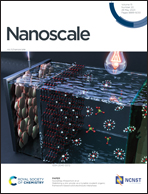Tuning interfacial two-component superconductivity in CoSi2/TiSi2 heterojunctions via TiSi2 diffusivity†
Abstract
We report the observation of enhanced interfacial two-component superconductivity possessing a dominant triplet component in nonmagnetic CoSi2/TiSi2 superconductor/normal-metal planar heterojunctions. This is accomplished through the detection of odd-frequency spin-triplet even-parity Cooper pairs in the diffusive normal-metal component of T-shaped proximity junctions. We show that by modifying the diffusivity of the normal-metal part, the transition temperature enhancement can be tuned by a factor of up to 2.3 while the upper critical field increases by up to a factor of 20. Our data suggest that the C49 phase of TiSi2, which is stabilized in confined geometries, underlies this enhancement. These findings are addressed via a Ginzburg–Landau model and the quasi-classical theory. We also relate our findings to the enigmatic 3-K phase reported in Sr2 RuO4.



 Please wait while we load your content...
Please wait while we load your content...